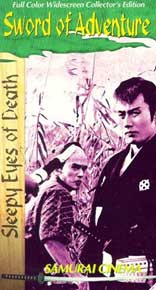 Nemuri Kyoshiro shobu (Daiei, 1964) is the second in the series based on a pulp fiction antihero who first became known in the west as The Full Moon Swordsman named after his mesmerizing sword style, or the Son of the Black Mass series because of Kyoshiro's unwholesome origins which, in the early episodes, is not revealed. Nemuri Kyoshiro shobu (Daiei, 1964) is the second in the series based on a pulp fiction antihero who first became known in the west as The Full Moon Swordsman named after his mesmerizing sword style, or the Son of the Black Mass series because of Kyoshiro's unwholesome origins which, in the early episodes, is not revealed.
Much later, with American video tape releases in the 1990s, these films were given the new series name Sleepy Eyes of Death series, & also carries the series title The Adventures of Nemuri Kyoshiro on the subtitled prints themselves.
Those of us who saw 35 mm prints in the 1960s & 1970s still think of the series as The Full Moon Swordsman, but younger viewers of the video age know him as Sleepy Eyes of Death. The second installment of the series is variously known as The Duel or Showdown, & most recently distributed as The Sword of Adventure.
The character was well enough known in Japan that it was not necessary to over explain Kyoshiro's history, but it helps western viewers to know in advance that he's a ronin by choice & could be hired instantly for his great skill if he wanted to serve any lord. He has reddish-hued hair because he's actually Eurasian, son of noblewoman & a European satanist who raped Kyoshiro's mother on a night of a black mass.
He holds balanced within him traits of good & evil, & can be a champion of the innocent & sentimental lover to women he assesses as decent, or a killer & rapist to those he assesses as vile or overly proud. He views himself as a villain foremost, though many others expect heroic acts from him. Only if it will keeps him from being bored will he live up to heroic expectations. Though in general true innocence is safe in his company, who among us is ever truly innocent.
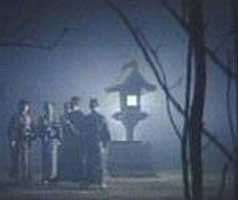 As the second film opens, Kyoshiro pursues a girl pickpocket & undresses her with his sword. Stripping women with his sword is something he does in several of these films, & sometimes rapes them as well, for he is a judgemental fellow & if he decides you're a bad woman he's apt to humiliate you sexually, just like when he decides you're a bad alpha male he'll kill you. As the second film opens, Kyoshiro pursues a girl pickpocket & undresses her with his sword. Stripping women with his sword is something he does in several of these films, & sometimes rapes them as well, for he is a judgemental fellow & if he decides you're a bad woman he's apt to humiliate you sexually, just like when he decides you're a bad alpha male he'll kill you.
Some viewers are troubled by this "heroic" figure's easy maltreatment of women, but he's a lot more complex than that, & it has to be understood that as a son of the black mass there is a streak of evil in Kyoshiro. He's by no means a standard heroic type. Whatever society most values, he dislikes.
A little orphaned samurai boy makes a living pushing old people up a staircase for spare change. His father had once owned a dojo but was killed by a challenger who took over the school. The slain man was one of Kyoshiro's instructors, & when the boy sees Kyoshiro in a swordfight, he sees his "father's image" in Nemuri's fighting posture.
In the main plot thread, Akaza Gunbei wants to kill the old financial commissioner, Asahina. Kyoshiro happens to have befriended the old gent & so chases off the killer ronin. Far from being angry that someone tried to kill him, the old man feels sorrow for his attacker. Kyoshiro annoys the old guy by always being near to protect him.
Shiho Fujimura is a recurring leading lady for Raizo Ichikawa, & this time she plays a wandering fortune-teller, Uneme. She is married to a foreign Christian who was imprisoned for spreading his faith. Johanness is someone Kyoshiro encountered while Christians were being rounded up & arrested, & he was impressed with the man.
The fortune-teller Uneme appears to be a spy for one Princess Taka. Takahime has secretly ordered the assassination of Asahina because as financial commissioner he has been showing the shogunate where they can cut back on expenses, including the good idea of reducing the princess's hefty allowance.
Since Kyoshiro is getting in the way of the princess's intentions, the fortune-teller drugs him into paralysis & he awakens in the presence of Takahime. She is eager "to have my way with you." But he insults her as "Princess Pig," & makes light of her position since she's really only one of fifty bastards of the shogun. He kills one of her lovers & escapes once more to protect the old man.
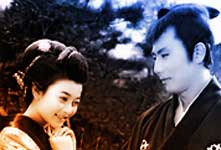 Kyoshiro's full character is not really in play by the second film. Although in most episodes he commits frequent heroic acts, he does so with a sardonic attitude & for strictly personal reasons. He is not the Zatoichi or Robin Hood sort to rush to the aid of others because they need him.
Kyoshiro's full character is not really in play by the second film. Although in most episodes he commits frequent heroic acts, he does so with a sardonic attitude & for strictly personal reasons. He is not the Zatoichi or Robin Hood sort to rush to the aid of others because they need him.
Yet in this episode he becomes the self-appointed bodyguard of the elderly, ind, & naive polical reformer, doing so quite selflessly. This would seem to contradict his character in the films to follow, a man reluctant to meddle in the affairs of others, a man who considers himself villainous & in many cases acts like it.
He's also a little less misogynist than in the bulk of the episodes, although all the elements of his sexual arrogance are here. When the vaillainous princess seeks Nemuri's sexual favor, he's incensed. "How dare you touch my pure body!" In no other film would he suggest himself in any manner "pure," though he would indeed reject countless aristocratic lady villains who feel an attraction for his beauty & even for his cruel nature, feeling perhaps an affinity between his brand of villainy & their own.
Nemuri prefers women who are virginal of spirit, not necessarily literally virgins, who offer themselves reluctantly (perhaps as payment for helping someone they love). He also likes prostitutes who have no remaining illusions, for they are at least honest in their hearts. Yet in Nemuri Kyoshiro Shobu contrary to his later portrayals, Nemuri is capable of a strictly platonic relationship with an innocent noodleshop girl.
In both Trail of Traps (Nemuri Kyoshiro Burai-Hikae masho no hada, 1967) & the very first episode Enter Kyoshiro Nemuri, the Swordsman, aka, The Chinese Jade (Nemuri Kyoshiro sappochi, 1963) he falls in love with doomed, virginal women; but these are nearly teh sum total of exceptions. He is just not a man generally capable of liking women for more than physical pleasure. Those who are too pure he robs of their illusions; those of infamy he gladly kills, sometimes, as in Kyoshiro Nemuri at Bay (Kyoshiro Nemurai Joyoken, 1964), killing villainous women who are unarmed & helpless.
In the twelfth & final film Raizo made about this character, Castle Menagerie aka, Hunt for the Wicked Woman (Nemuri Kyoshiro Akujo-gari, 1969), the princess-villain is purposedly used as a shield to stop an arrow. She is killed by Kyoshiro despite having been by this point completely relieved of her aspirations to power, defanged as it were. yet Nemurai is as merciless with an unarmed lady villain as he is with an armed male villain.
There is no room for either emotional or physical vulnerability in Kyoshiro Nemuri's world. His deeds are morally questioniable. Our responses to these films -- our ability to enjoy them a whole lot even understanding how they lack moral clarity -- is perhaps not entirely healthy.
Yet, because of Raizo Ichikawa's unique physical beauty, & the simultaneously repulsive & intriguing nature of the character he plays, it is easy to have positive feelings about a fellow whose moral laxity is outmatched only by his arrogant self-righteousness, the very traits he despises in others.
In this second installment he's not quite as bad as all that. As the series progresses his heroism weakens, his misogyny grows more intense. The real reason he was closer to the standard heroic ronin in the first three films is because the studio was afraid of the full ramifications of the original character & had him toned down. But treating him as a real figure, it is interesting to suppose he actually deteriorates morally as he sees, & participates in, increasing amouonts of violence & injustice & chicanery in the world.
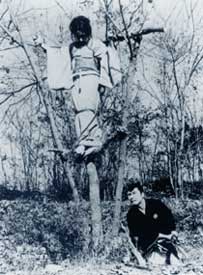 He changes a lot, & for the worse, though for the better in terms of becoming a fascinating character in whom good & evil are on easy terms. Perhaps his Zen-like pretense of being unconcerned hides a bitterness about his world & his role in it, though there was a time, as in this second film, when his outlook was not so bleak. He changes a lot, & for the worse, though for the better in terms of becoming a fascinating character in whom good & evil are on easy terms. Perhaps his Zen-like pretense of being unconcerned hides a bitterness about his world & his role in it, though there was a time, as in this second film, when his outlook was not so bleak.
Earlier in Nemuri Kyoshiro Shobu, five ronin had met Kyoshiro on a foggy evening, desirious of killing him. One is shuriken artist. Another a spearman. We are not treated to their duel immediately, but do expect them to turn up later. After leaving the unwanted company of the princess, Kyoshiro encounters the spearman again. This man believes he can defeat Kyoshiro's Full Moon style if he attacks when the circling sword passes in front of Kyoshiro's own vision.
Another of the five observes that the circling sword motion is mesmerizing & frightening, & sees also that the spearman's plan to penetrate the form wasn't even close to working in his favor.
Kyoshiro claims that when he starts the full moon sweep of his blade, death is assured for his opponent, so another of the five attempts to attack before Kyoshiro can begin the Full Moon circle.
The last of the five will elect to wait until the circle is entirely traced & see if he can't break through the stance at the end of the circle. Even though the outcomes of duels for an open-ended series hero are a forgone conclusion, the variations of assaults add a definite spice to the elegant action.
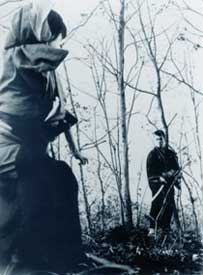 This is one other element more understated for the second episode than would be the case in films to follow: There is some slight intimation that Kyoshiro is not totally invulnerable. His near-duel with Lord Yagyu, the greatest swordsman of his generation, is aborted, so we never know whether or not Kyoshiro was better than the best. This is one other element more understated for the second episode than would be the case in films to follow: There is some slight intimation that Kyoshiro is not totally invulnerable. His near-duel with Lord Yagyu, the greatest swordsman of his generation, is aborted, so we never know whether or not Kyoshiro was better than the best.
This is probably in emulation of Musashi Miyamoto, who in life in film versions of his life as well as in history also never pitted him against the Yagyu sword, though he nearly had that opportunity.
One of the underlying premises of Nemuri Kyoshiro Shobu is that there has to be some area of vulnerability in Kyoshiro's seemingly impenetrable Engetsu or Full Moon Cut. In no other film are we allowed to worry about the safety of arrogant, invulnerable Kyoshiro Nemuri.
And that fact does reduce the dramatic effect of some of his duels, since all outcomes are telegraphed from the start: real bad guys will die, quasi-bad-guy Kyoshiro will live uninjured. Zatoichi as a series character also always has to live, but he can be badly injured & is always at some risk. Nemuri is not, unless in this second episode.
The Engetsu cut is a purely cinematic & visual thing, hardly practical, & it is even suggested in several episodes that the style makes no logical sense but functions by some mystic, mesmerizing principle. Visually it looks super on the screen. The sword is held flat -- side toward the oponent & pointed downward -- then brought around slowly in a full circle like the hand of a clock.
If a foe attacks when the sword is at nine o'clock, twelve o'clock, or if he waits until the sword has completed the circle & starts again, there seems to be no entry point that will succeed against this full moon form. A clever foe gets Kyoshiro into a thicket of saplings, thinking at last the ronin will be unable to make the circular motion. But he draws his sword in a rapid arc &, as he prepares to start his slow-motion ful moon form, all the saplings fall to the ground, cut by the initial iai draw.
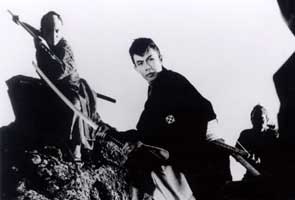 Along the way Uneme has fallen for Kyoshiro, & she'll save him from an assassination attempt which she herself had been instructed to arrange. Along the way Uneme has fallen for Kyoshiro, & she'll save him from an assassination attempt which she herself had been instructed to arrange.
The evil Princess Taka sets up an exhibition duel between Kyoshiro & Lord Yagyu. She has had the duel rigged, but Kyoshiro detects the trick, & causes an unexpected outcome. Lord Yagyu having been fooled, too, reports to the shogun, resulting in the exile of the princess.
The wicked aristicratic villainous would remain a stock character of the series. In The Princess's Mask (nemuri Kyoshiro tajo ken, 1963) a noblewoman is driven to villainy by her disfigurement. Kyoshiro Nemuri at Bay opens with an insane princess killing an innocent lady-in-waiting. The Human Tarantula (Nemurai Kyoshiro hotohadgaumo, 1968) features a princess who delights in killing, as also in Castle Menagerie.
One could almost suspect a pathological hatred of women manifesting among the screenwriters, but keeping the attitude that Kyoshiro is real, it would appear that he is drawn again & again to something that fascinates him & he must pursue if only to destroy it.
Every episode in this series is nicely done, & this one has an especially reliable director. Even so, the best episodes are yet to come, as the more perverse & incorruptibly cruel Kyoshiro is portrayed as being, the sexier & cooler he will be.
copyright © by Paghat the Ratgirl
|
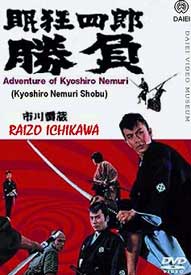



 He changes a lot, & for the worse, though for the better in terms of becoming a fascinating character in whom good & evil are on easy terms. Perhaps his Zen-like pretense of being unconcerned hides a bitterness about his world & his role in it, though there was a time, as in this second film, when his outlook was not so bleak.
He changes a lot, & for the worse, though for the better in terms of becoming a fascinating character in whom good & evil are on easy terms. Perhaps his Zen-like pretense of being unconcerned hides a bitterness about his world & his role in it, though there was a time, as in this second film, when his outlook was not so bleak. This is one other element more understated for the second episode than would be the case in films to follow: There is some slight intimation that Kyoshiro is not totally invulnerable. His near-duel with Lord Yagyu, the greatest swordsman of his generation, is aborted, so we never know whether or not Kyoshiro was better than the best.
This is one other element more understated for the second episode than would be the case in films to follow: There is some slight intimation that Kyoshiro is not totally invulnerable. His near-duel with Lord Yagyu, the greatest swordsman of his generation, is aborted, so we never know whether or not Kyoshiro was better than the best.